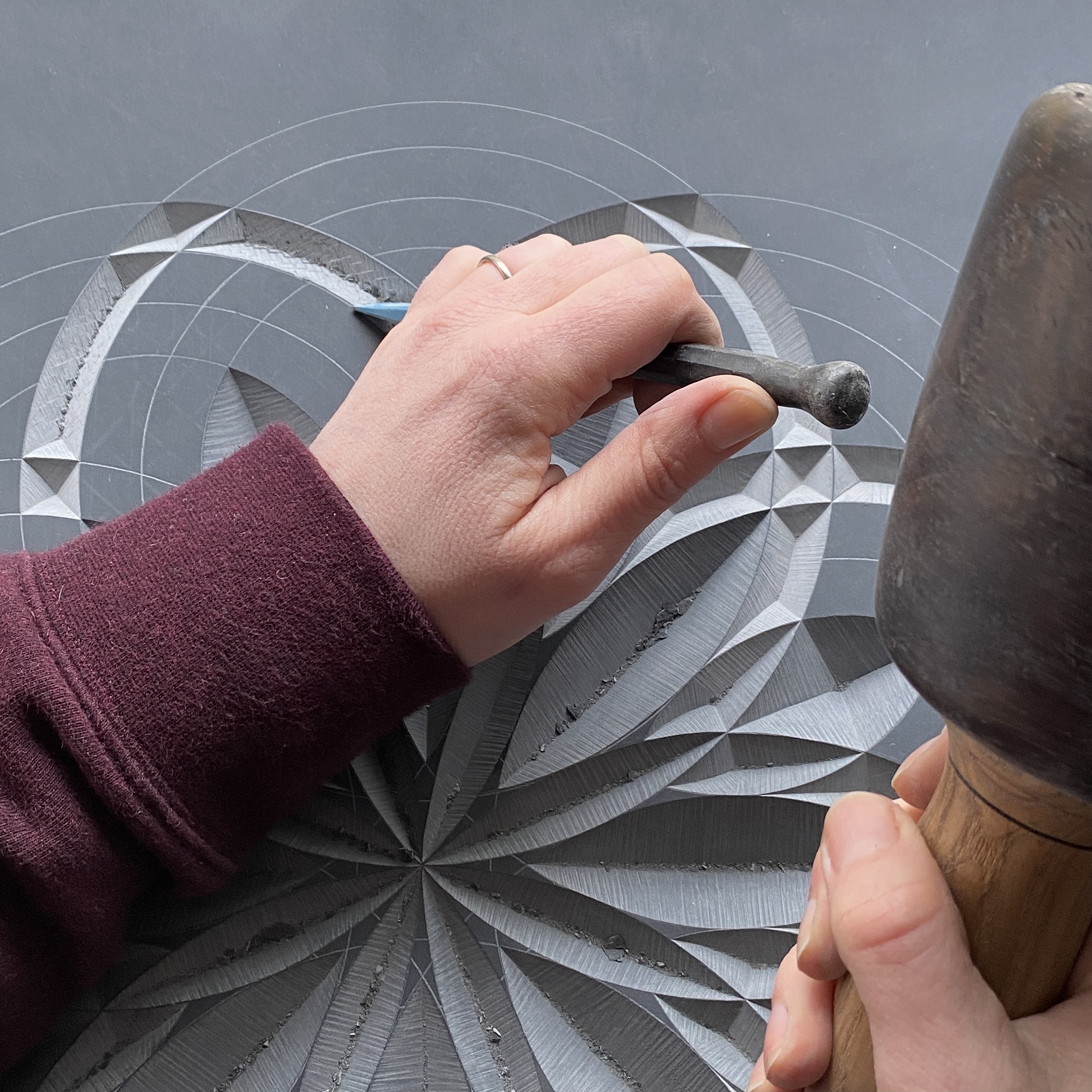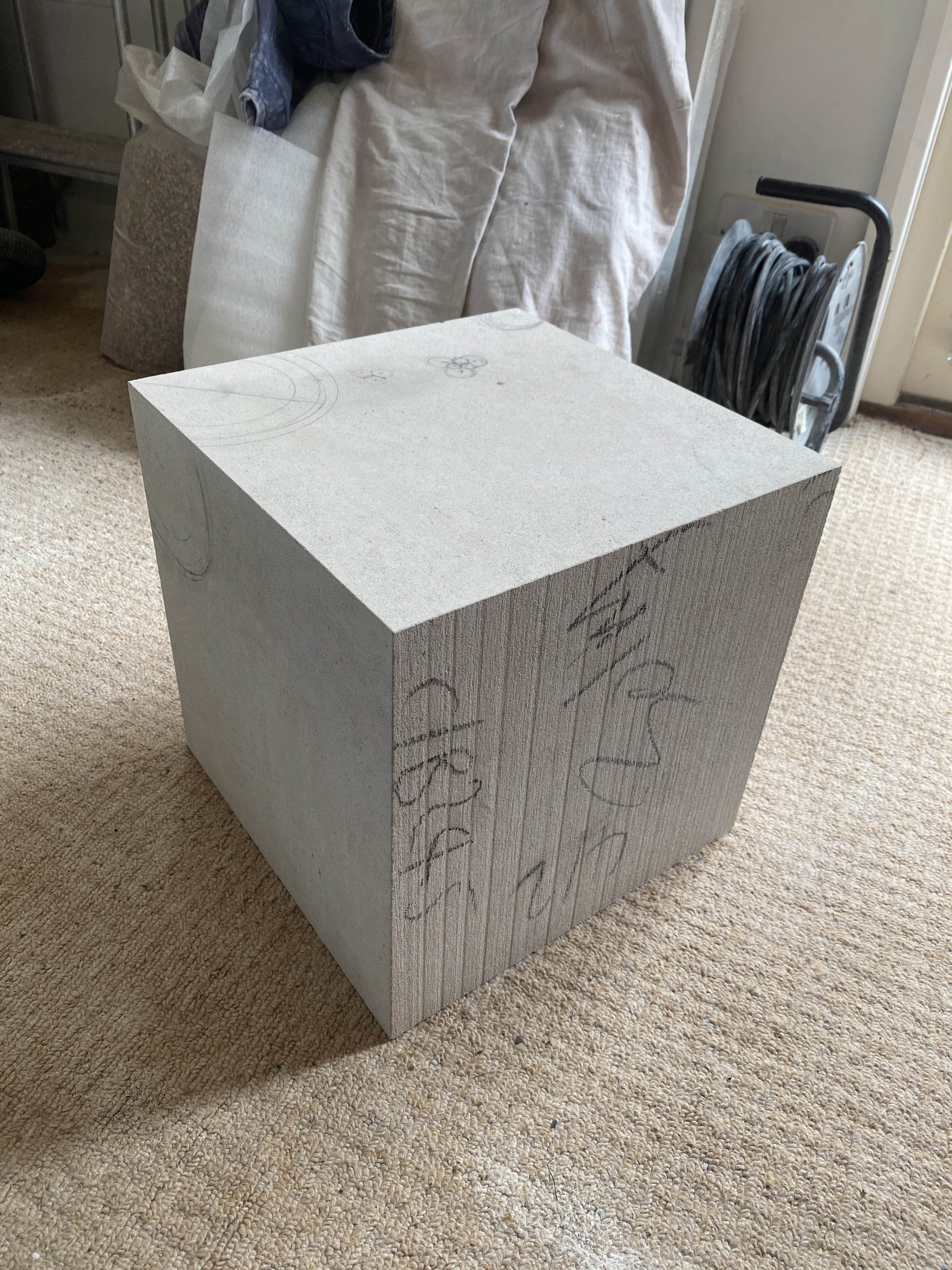Creating New Work
Ever wondered how artists create new work?
Let me take you through my thought processes of how I develop ideas and what I’m considering for my next piece of carving
Previous Work
Whilst planning my next piece of work I’ve been looking back at previous carvings and considering which elements I want to develop.
This is often how I start to move onto the next piece, I want my work to continue to develop and grow, building on from previous ideas feels like the natural way to do this.

Close up of Sequins showing the surface texture and chisel marks
The importance of sequins
Sometimes I make a piece of work, which feels like a turning point, or particularly successful. I look back at these pieces regularly to revisit what I found successful. Sequins, pictured above is one of those pieces.
The texture from the chisel marks and the interlocking pattern has always been really appealing to me. It opened my eyes to the beauty of the individual chisel marks and made me question why I found that important.
The length of time it takes to make my work is at the heart of what makes it special. A record of time passing, a presence of the maker which lasts forever.
It reminds me of the luxury to make slowly in such a busy world.
A hand written letter
Whilst I consider previous work, there are of course new ideas to be considered.
I received a letter from a friend recently, it was hand written. This hand written element made it felt very special, I’ve been thinking about why this is.
For me I think that the hand written letter shares similar properties to the enjoyment I get from hand crafted work. The ink leaves a physical mark of the writers existence, a legacy.
When people are far away this physical mark brings them closer to you. It means you are able to touch where their hands have touched and read the words they thought about writing.
The viewers involvement
Continuing on from my interest in the presence of the maker leads me to wanting to involve the viewer and also considering what I want to achieve.
Recently I spent time demonstrating my craft at Artefact. I also got to secretly watch how people engage with my work.
It appears to me that mostly something sparks their interest from afar, maybe the pattern or the material, then they are drawn to move in closer and see how it is constructed.
These different levels of engagement are something which I have always loved about art work. I like it when work surprises, challenges or maybe delights somehow. I especailly like when something unexpected happens.

At Design Centre, Chelsea harbour, London as part of Artefact 2021. Cleaning the slate on setup day.
The importance of acuracy
We are so used to seeing machine production, that I feel perfection is almost now expected. People quite often comment that they initially thought that my work was machine made. On closer inspection they are usually delighted to find that it’s made by hand.
This joy of discovery and then interest in the process wouldn’t happen if the pattern wasn’t executed as accurately as I could manage.
For me this makes the accuracy in the carving really important as it adds a wonderful dichotomy.
I feel the accuracy also tells the viewer something about me as the maker. My craft takes time, it is not about speed but about quality. I want to make it as good as I possibly can.
There’s a care and consideration of every element from design to creation. I work hard, I have studied for many years, concentrated on learning and developing my skills. This is not just my work but an incite into me as a person too.

Hand drawn geometric pattern for a previous carving
Perfection in geometry
Geometry plays an important role in my work. I really enjoy pattern, and accurate patterns even more so. I find that perfection is often what makes something satisfying.
For example the images which pop up on Pinterest of coloured pencils all lined up, there’s something about that which brings me joy whilst making me feel calm.
Due to this love of perfection, geometry feels like the perfect fit to convey that.
However a geometric pattern wouldn’t be as satisfying if it wasn’t accurate (and for most people too I suspect). This increases the challenge to create the work. For me it raises the bar on my craft. There’s nowhere to hide, if I make a mistake you will see it, it is open and honest.

Close up detail of Merak. Hand carved Welsh slate, 2021
How to push forward
So with all these elements to consider spinning around in my head, it can cause a bit of a ‘writers block’. How do you start when you want to achieve so much. What if the resulting carving doesn’t fulfil the brief I’ve set?
One great lesson I learnt at college is you should ‘just do’. Don’t discount an idea before you have tried it, but learn and develop WHILST you’re making it.
This removes the pressure and means that to me each piece of work feels experimental and more like an underdog which might surprise me!
Each carving is exploring an idea. Some feel really successful, others less so. The real joy is that as we all see the world differently, a carving which might feel less successful to me might really speak with someone else, and therefore is just as successful.

My space to think!
Thinking Whilst Carving
I have also learnt over the years, that if I sit down and have to think of an idea, nothing much will come out!
I mostly enjoy considering the next carving and developing ideas whilst I’m in the thick of carving a different piece.
The decisions have all be made for this piece and I just have the enjoyment of carving it. I’m concentrating wholeheartedly on the design in front of me, which just allows my brain to wander around new ideas with no pressure.
When the questions start
Which is when the questions start! Sometimes is comes as a ‘how can I achieve this’ question, about pattern or texture. Other times it’s the practical application of a different technique or idea. Sometimes it’s the antidote to a previous work….circles and curves came after carving a lot of straight lines!

The new block of Portland stone ready and waiting to be carved!
The new work
For the next piece I wanted to challenge myself and break free from wall pieces. I have a cube of stone sitting in front of me which I imagine will sit on a plinth/table/floor so the viewer can move around it.
I don’t want this to be a departure from my geometric wall art, but a development. I’ve spent a lot of time considering what I am trying to achieve and what new ideas a cube allows me to play with.
6 surfaces, 12 edges and 8 corners is an interesting and exciting space!
